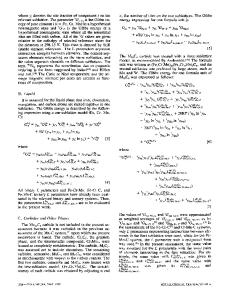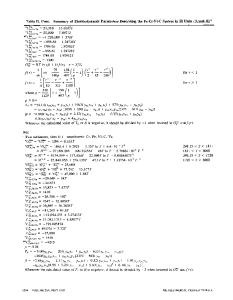A thermodynamic evaluation of the Fe-Mn-N system
- PDF / 1,403,513 Bytes
- 17 Pages / 597.28 x 785 pts Page_size
- 73 Downloads / 341 Views
I.
INTRODUCTION
N I T R O G E N has a strong effect on the properties o f steels during various processes. Particularly, due to several beneficial roles, such as stabilizing austenite, solid solution strengthening, and improving pitting corrosion resistance, nitrogen has been used as an alloying element in austenitic stainless steels. From practical experience, it has been known that by an addition o f Mn, w h i c h is a common alloy element, steels can dissolve more nitrogen in liquid o r solid solution state and, thus, gain more improvements o f the properties. In particular, pore formation during solidification can be avoided. In o r d e r to understand the behavior o f Mn and N in steels, the study o f the thermodynamic properties and the phase diagrams o f the systems with Mn and N is a subject o f great theoretical and practical importance. In the present work, we will consider the key ternary Fe-Mn-N system. Many experimental works on the Fe-Mn-N system have been carried out over the years to determine the solubilities o f N in the F e - M n melt t1-131 and austenite (fcc phase) tma-z°] under various conditions, and a few investigations have also been made regarding ferrite (bcc phase). [2t,22j In addition, Rawlings and Hatherley tz:J proposed a tentative Fe-rich c o m e r o f the Fe-Mn-N phase diagram at 550 °C based on their measurements o f the solubility o f Mn nitrides in ferrite. Recently, Burdese et al.t23~ examined the solubility o f Fe in the Mn nitride MnaN and presented an isothermal section o f the Fe-Mn-N system at 500 °C. Most o f the experimental information available in 1987 was compiled by Raghavan.t24~ There are also several attempts to describe the solubility o f N either in liquid t9'25-:71 o r in austenite [19,z°J on the basis o f thermodynamics. However, no effort has been made to analyze the whole system and assess it thermodynamically. The purpose o f the present work was to assess the properties o f the Fe-Mn-N system by taking all experimental information into account and then to obtain a consistent thermodynamic description. The assessment approach involves the use o f thermodynamic models f o r the molar Gibbs energy o f the various phases in the system. In the models, the parameters o f pure components
Fe, Mn, and N were t a k e n from References 28 through 30 and those o f the binary Fe-N, Mn-N, and F e - M n systems were t a k e n from recent studies,t3°-32] whereas the ternary parameters were evaluated from experimental information. The parameter evaluation is performed through a computer-operated optimization program. Once a complete description o f the Fe-Mn-N system has been obtained in this way, its phase d i a g r a m and various thermodynamic properties can be calculated by applying standard thermodynamic methods.
II.
THERMODYNAMIC M O D E L I N G
The Fe-Mn-N system contains the following four types o f phases: liquid, solid solution phase [ a ( c b c c ) based on a - M n , /3(cub) based on /3-Mn, y(fcc), 8(bcc), and hcp(Me2N)], nitrides [MeaN, 'o(Mn6Na), and 0(Mn6
Data Loading...











